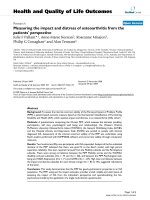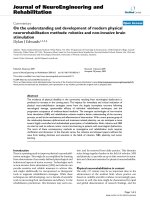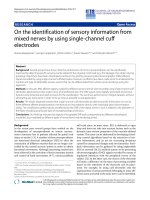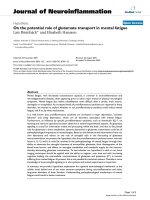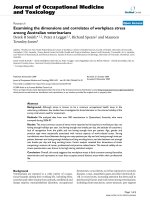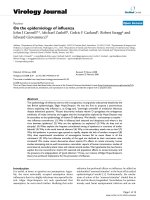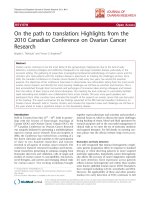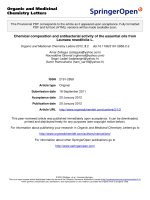Báo cáo hóa học: " On the Enhanced Antibacterial Activity of Antibiotics Mixed with Gold Nanoparticles" pot
Bạn đang xem bản rút gọn của tài liệu. Xem và tải ngay bản đầy đủ của tài liệu tại đây (482.64 KB, 8 trang )
NANO EXPRESS
On the Enhanced Antibacterial Activity of Antibiotics Mixed
with Gold Nanoparticles
G. L. Burygin Æ B. N. Khlebtsov Æ A. N. Shantrokha Æ
L. A. Dykman Æ V. A. Bogatyrev Æ N. G. Khlebtsov
Received: 17 December 2008 / Accepted: 6 April 2009 / Published online: 21 April 2009
Ó to the authors 2009
Abstract The bacterial action of gentamicin and that of a
mixture of gentamicin and 15-nm colloidal-gold particles on
Escherichia coli K12 was examined by the agar-well-dif-
fusion method, enumeration of colony-forming units, and
turbidimetry. Addition of gentamicin to colloidal gold
changed the gold color and extinction spectrum. Within the
experimental errors, there were no significant differences in
antibacterial activity between pure gentamicin and its mix-
ture with gold nanoparticles (NPs). Atomic absorption
spectroscopy showed that upon application of the gentami-
cin-particle mixture, there were no gold NPs in the zone of
bacterial-growth suppression in agar. Yet, free NPs diffused
into the agar. These facts are in conflict with the earlier
findings indicating an enhancement of the bacterial activity
of similar gentamicin–gold nanoparticle mixtures. The
possible causes for these discrepancies are discussed, and the
suggestion is made that a necessary condition for enhance-
ment of antibacterial activity is the preparation of stable
conjugates of NPs coated with the antibiotic molecules.
Keywords Colloidal-gold nanoparticles Á Gentamicin Á
Drug delivery Á Antibacterial activity Á Agar-well-
diffusion method Á Minimum inhibitory concentration Á
Maximum tolerant concentration Á Atomic absorption
spectroscopy
Introduction
Over the recent decade, gold nanoparticles (NPs) [1–3]
have attracted significant interest as a novel platform for
various applications such as nanobiotechnology and
biomedicine [4–7] because of convenient surface biocon-
jugation [8] with molecular probes and remarkable plas-
mon-resonant optical properties [9]. Recently published
examples include applications of NPs to biosensorics [10],
genomics [11, 12], clinical chemistry [13], immunoassays
[14], immune response enhancement [15], detection and
control of microorganisms [16], optical imaging of bio-
logical cells (including cancer cell imaging with resonance
scattering [17, 18], optical coherence tomography [19],
two-photon luminescence [20], and photoacoustic [21, 22]
techniques), cancer cell photothermolysis [23, 24], and
targeted delivery of drugs or genetic and immunological
substances [25–29]. In particular, there is great interest in
the development of nanoparticle-based vectors that
decrease the toxicity of free drugs and ensure targeted
delivery directly to tumor cells [30–33
]. Gold NPs have
been used for delivery of not only antitumor agents, but
also insulin [34], tocopherol [35], and other drugs [16, 29].
Conjugates of gold NPs with antibiotics and antibodies
also have been used for selective photothermal killing of
protozoa and bacteria [36–38]. In regard to antibacterial
activity, Williams et al. [39] showed that gold NPs them-
selves do not affect bacterial growth or functional activity,
whereas conjugates of vancomycin to gold NPs decrease
the number of growing bacterial cells [37]. Gu et al. [40]
synthesized stable gold NPs covered with vancomycin and
G. L. Burygin Á B. N. Khlebtsov Á L. A. Dykman Á
V. A. Bogatyrev Á N. G. Khlebtsov (&)
Institute of Biochemistry and Physiology of Plants and
Microorganisms, Russian Academy of Sciences, 13 Prospekt
Entuziastov, 410049 Saratov, Russia
e-mail:
G. L. Burygin Á A. N. Shantrokha Á V. A. Bogatyrev Á
N. G. Khlebtsov
Saratov State University, 83 Ulitsa Astrakhanskaya, 410026
Saratov, Russia
123
Nanoscale Res Lett (2009) 4:794–801
DOI 10.1007/s11671-009-9316-8
showed significant enhancement of antibacterial activity
for this conjugate, in comparison with the activity of the
free antibiotic. A similar result was reported for cipro-
floxacin conjugated with Au/SiO
2
core/shell NPs [41].
In contrast to gold NPs, silver NPs may exhibit anti-
bacterial activity [42]. Furthermore, silver NPs were shown
to enhance the antibacterial activity of penicillin G,
amoxicillin, erythromycin, clindamycin, and vancomycin
against Staphylococcus aureus and Escherichia coli [43].
Similar conclusions were reported on the antibacterial
activity of silver and gold NPs stabilized with hyper-
branched poly(amidoamine), containing terminal dimeth-
ylamine groups [44].
It should be emphasized that in the above-cited studies
[37, 40, 41], the authors used NPs functionalized with
antibiotics by physical or chemical adsorption. Compared
with bare NPs, stable conjugates exhibited small changes in
the absorption spectra. For the naked eye, the conjugated
sols retained their red color, typical of colloidal-gold sols.
In 2007, four papers have been published [45–48],
reporting the use of blue aggregated mixtures of drugs
and GNPs, rather than of stable red conjugates. Such a
color change and transmission electron microscopy
(TEM) images unambiguously indicated NP aggregation
[49]. The drugs used were aminoglycoside antibiotics
(streptomycin, gentamicin, kanamycin, and neomycin),
quinolones (ciprofloxacin, gatifloxacin, and norfloxacin),
ampicillin (a penicillin antibiotic), and 5-fluorouracil (an
antimetabolite of nucleic metabolism). The preparations
obtained by the authors were tested for antibacterial
activity toward gram-positive (S. aureus, Micrococcus
luteus) and gram-negative (E. coli, Pseudomonas aeru-
ginosa) microorganisms, and they also were examined for
antifungal activity toward Aspergillus fumigatus and
Aspergillus niger. The basic experimental tests for the
determination of antibacterial activity were the disk dif-
fusion method [45, 46, 48] and the agar-well-diffusion
method [47]. Depending on the antibiotic used, increase
in the activity of the antibiotic–colloidal-gold mixture
ranged from 12 to 40%, as compared with the activities of
the native drugs. From those data, the authors concluded
that the antibacterial activities of the antibiotics were
enhanced through the use of gold NPs [45–48].
However, as noted by the authors themselves [43–48],
the question of the mechanisms governing possible
enhancement of the antibacterial action of drugs or
polymers remains unanswered. Whereas several hypothe-
ses have been raised for aggregatively stable NP–antibi-
otic conjugates [40], the enhancement mechanism for
aggregated NP–antibiotic mixtures—if it exists at all—is
absolutely incomprehensible, at least when the activity of
preparations is assessed by the agar-well-diffusion
method. First, no gold NPs have been shown to be present
in the agar zone of bacterial-growth inhibition. Antibiotic
addition to an NP suspension leads to NP aggregation,
readily detectable with extinction spectra and with TEM
images. The question now arises, can particle aggregates
diffuse into agar at all? Let us suggest for a moment that
diffusion is impossible. In that case, the question of
enhancement of antibacterial action loses its meaning
altogether. Here, therefore, we decided to examine the
antibacterial activity of an NP–antibiotic mixture and to
simultaneously investigate the penetration of particles into
agar.
We explored the antibacterial activity of a mixture of
gentamicin and colloidal-gold particles (average diameter,
15 nm) toward E. coli R12, by using the agar-well-diffu-
sion method, enumeration of colony-forming units (CFUs),
and turbidimetry. Gentamicin was chosen on the basis of
the following reasons. First, as an aminoglycoside antibi-
otic, gentamicin is of unquestionable practical interest.
Being a mixture of gentamicins C1, C2, and C1a, it is
bacteriostatic to many gram-positive and gram-negative
microorganisms, including E. coli, Proteus, Salmonella,
and penicillin-resistant Staphylococcus strains. The mech-
anism of gentamicin action is linked to disruption of
ribosomal synthesis of protein, and microbial resistance to
gentamicin develops fairly slowly. Gentamicin is a major
agent used to treat severe purulent infection, especially that
caused by a resistant gram-negative flora. As a broad-
spectrum antibiotic, gentamicin is often prescribed for
patients with mixed infection and also when the infecting
agent has not been identified. Sometimes gentamicin is
effective when other antibiotics display insufficient activity
[50].
Second, gentamicin was chosen because, as found pre-
viously [45], a mixture of gentamicin and gold NPs has the
most enhanced activity toward E. coli. It is this result,
along with the need to study particle penetration into agar,
that prompted this research.
Experimental Section
Preparation of Gold NPs
Gold NPs were prepared by the reduction of tetrachloro-
auric acid with sodium citrate [51]. A 242.5-mL portion of
0.01% aqueous tetrachloroauric acid (Aldrich, USA) was
heated on an MR 3001 magnetic stirrer (Heidolph,
Germany) in an Erlenmeyer flask fitted with a water-cooled
reflux tube. This was followed by the addition of 7.5 mL of
1% aqueous sodium citrate (Fluka, Switzerland) to the
flask. The mean particle diameter (16 nm) was controlled
by spectrophotometric calibration [52].
Nanoscale Res Lett (2009) 4:794–801 795
123
Preparation of a Gentamicin–NP Mixture
We used an aqueous stock solution of gentamicin sulfate
(Fluka, Switzerland; activity, 636 U mg
-1
; concentration,
4.5 mg mg
-1
). Immediately before being added to the
culture medium or to the gel wells, the antibiotic solution
was mixed 1:1 either with 2 mM K
2
CO
3
or with gold NPs
in the same solution. In agar-well-diffusion experiments,
we also made a series of twofold dilutions of the free-
gentamicin solution and of the gentamicin–NP mixture.
The formation of Au–Gm complex can be easily mon-
itored by UV–Vis spectra (S-300 spectrophotometer,
Analytik Jena, Germany). The initial 16-nm gold colloid
exhibits well-known plasmon resonance near 520 nm.
Immediately after addition of Gm, we observed drastic
change in the colloid color from wine red to purple blue.
To follow such kinetics in detail, we decreased the con-
centration of Gm 20 times (up to 0.05 lgmL
-1
) as com-
pared to the average concentration used in microbial assay
(Table 1). The time-dependent UV–Vis spectra were
recorded after mixing (1:1 v/v) Au colloid with Gm at
timed interval 30 s (step, 1 s). A portion of spectra is
shown in Fig. 1. The appearance of a new red-shifted peak
near 650–670 nm is a typical signature of a fast NPs
aggregation. Indeed, such a phenomenon has been descri-
bed in numerous reports; for details, the readers are
referred to review Ref. [53].
Bacterial Strain and Growth Conditions
E. coli R12 obtained from this institute’s collection was
used for this study. The strain was grown in Luria–Bertani
(LB) medium at 37 °C. All inoculation experiments used
an overnight accumulation culture grown to stationary
phase in advance. The initial culture absorbance A
600
was
0.04. Bacterial growth was assessed by using the time-
dependent absorbance curve. The cell concentration was
estimated by the turbidity-spectra method [54].
CFU Enumeration
A bacterial suspension was mixed 1:1 with either a free-
gentamicin solution or a gentamicin–NP mixture and was
incubated at 37 °C for 1 h. For each treatment, six 10-fold
serial dilutions were made. A 200-lL volume of the
resultant suspension was uniformly spread onto overnight-
dried solid LB medium with a sterile spatula. After culti-
vation at 37 °C for 24 h, all the colonies grown were
enumerated, and the mean values and maximal scatter in
CFUs were determined.
Microbial Assay
Antibacterial activity was studied by the agar-well-diffu-
sion method, wherein a bacterial suspension was added to
sterile nutrient agar at 45 °C and the mixture was solidified
on a Petri dish. A 20-mL volume of the medium was
poured into a Petri dish (diameter, 90 mm) on a horizon-
tally leveled surface. After the medium had solidified,
4-mm-diameter wells were made in the agar (at six wells
per dish) that were equidistant from one another and from
the dish edge. The wells received either 20 lL of the free-
antibiotic solution or 20 lL of the antibiotic–NP mixture.
The Petri dishes were incubated in a thermostat at 37 °C
for 24 h. After incubation, the diameter of the zone of
bacterial-growth inhibition was measured with an accuracy
of ±0.1 mm. The mean inhibition-zone diameter and the
maximal data scatter also were determined. All experi-
ments were repeated thrice.
Determination of the Minimum Inhibitory
and Maximum Tolerant Concentrations
In experiments to determine the minimum inhibitory con-
centration (MIC) and the maximum tolerant concentration
Table 1 Antibacterial action of gentamicin and a gentamicin–NP
mixture on E. coli K12
Gentamicin concentration
(mg mL
-1
)
Inhibition-zone diameter (mm)
Gentamicin Gentamicin ? NPs
0.563 9.9 ± 0.6 9.9 ± 0.6
1.13 11.6 ± 0.2 11.5 ± 0.2
2.25 12.3 ± 0.6 12.1 ± 0.55
40
06
00 800 1000
Wavelen
g
th, nm
0
0.2
0.4
Absorbance
0
1
10
30
20
Fig. 1 Time-dependent absorption spectra of NPs–Gm mixture
(1:1 v/v). The final concentration of NPs and Gm are 0.15 mM and
0.05 lgmL
-1
, respectively. The numbers near curves designate the
time after mixing (seconds), the curve 0 is the initial spectrum without
Gm
796 Nanoscale Res Lett (2009) 4:794–801
123
(MTC, equivalent to the ‘‘no observed effect concentra-
tion’’), culturing was done in microtitration-plate wells for
3 h. The initial culture absorbance A
600
was 0.04. The MIC
was taken to be the gentamicin concentration at which the
A
600
of the bacterial suspension after incubation was
almost the same as the initial A
600
, and the MTC was
numerically equal to the gentamicin concentration at which
the parameters of culture growth were close to those for the
control culture (without the antibiotic).
Atomic Absorption Spectroscopy
Ashing of samples was done with the addition of sulfuric
acid at 600–630 °C. The ash was then dissolved in a
mixture of concentrated hydrochloric and nitric acids. The
solution was evaporated to dryness, a necessary amount of
0.5 N hydrochloric acid was added, and the sample thus
prepared was analyzed for gold on an AAS-3 atomic
absorption spectrometer (Carl Zeiss, Germany). The reso-
nance line was 242.8 nm, and the spectral slit width was
0.35 nm. Under such conditions, the limit of detection is
0.02 lgmL
-1
and the linear working region is up to
20 lgmL
-1
.
Results and Discussion
Effect of the Antibiotic Concentration
Figure 2a is a photo of a Petri dish showing the zones of
inhibition of E. coli growth upon addition of free-genta-
micin and a gentamicin–NP mixture to the wells. The
antibiotic concentration in the wells was decreased by
twofold dilutions from 2.25 to 0.56 mg mL
-1
. It can be
seen that the gentamicin–NP mixture retarded bacterial
growth to a degree comparable to that demonstrated by the
free antibiotic. When the free antibiotic and its mixture
with NPs were diluted twofold, the diameter of the zone of
culture-growth inhibition was reduced to the same extent in
both cases. To obtain reliable statistical data, we ran five
independent experiments, with three replicates per experi-
ment. Figure 2b and Table 1 give averaged data indicating
that the antibacterial action of gentamicin did not differ
significantly from that of the gentamicin–NP mixture.
Effect of the Residual Particles and Supernatant Liquids
We next answered the question whether the mixture NPs
freed from unbound antibiotic in the solution showed
antibacterial action. Because gold particles on their own
did not have antibacterial activity (Fig. 3), our experiment
allowed us to assess (to an extent) the degree of antibiotic
binding to the particles and the possible enhancement of
antibacterial activity through the agency of the particles.
For this purpose, the gentamicin–NP mixture was centri-
fuged at 30009g, and the sediment was stirred in the same
volume of water and was applied to the wells.
We found (Fig. 3, wells 3 and 4) that the sediment NPs
did not cause the formation of a zone of culture-growth
inhibition at all. Yet, the supernatant liquids resulting from
centrifugation had the same degree of activity toward
bacterial growth as did the initial gentamicin–NP mixture
(Fig. 3, wells 7 and 8). We emphasize once again that in
our control experiments, neither colloidal gold itself nor
solvent (2 mM K
2
CO
3
) inhibited bacterial growth (Fig. 3,
wells 5 and 6).
Effect of the NP Concentration
The absence of enhancement of the antibacterial action of
the antibiotic–NP conjugates may have been due to the low
concentration of particles themselves. Therefore, we
examined the effect of the gold NP concentration on the
antibacterial action of the conjugates. For this purpose,
antibiotic solutions having the same concentration were
mixed with equal volumes of 0.1, 0.5, and 1.0 mM gold
(b)
00.511.522.53
Concentration of Gm [mg/mL]
0
4
8
12
16
Inhibition-zone diameter [mm]
Gm
Gm+GNP
(a)
Fig. 2 a Zones of inhibition of
the growth of E. coli K12 on
solid LB medium. Wells 1, 3,
and 5 received gentamicin,
whereas wells 2, 4, and 6
received gentamicin ? gold
NPs. The final antibiotic
concentration in the wells was
decreased by twofold dilutions
and was 2.25 (wells 1 and 2),
1.13 (wells 3 and 4), and
0.563 mg mL
-1
(wells 5 and 6).
b A diagram showing the
averaged results from five
independent experiments, with
three replicates per experiment
Nanoscale Res Lett (2009) 4:794–801 797
123
solutions in 2 mM K
2
CO
3
before being added to the wells.
Note that the gold concentration of as prepared 16-nm
particles was about 0.3 mM. Accordingly, the mass/volume
concentration is about 57 lgmL
-1
or, equivalently, the
particle-number concentration is about 1.4 9 10
12
mL
-1
.
After the preparation of a concentrated stock solution, the
above concentrations (0.1–1 mM) were obtained by corre-
sponding dilutions. The results (Fig. 4) show that the anti-
bacterial activity of the preparations decreased slightly with
increasing particle concentration, but from a statistical
analysis of the data, it follows that this effect is within the
error and is not significant.
Diffusion of Free Gentamicin and Its Complexes
with NPs into Agar
As said above, addition of the antibiotic to the NP sol led to
aggregation, confirmed by changes in the colloid color
and extinction spectrum and also by direct TEM
images. Consequently, the absence of enhancement of the
antibacterial action of the conjugates and particles sedi-
mented from the antibiotic–NP mixtures could be
explained by an inability of aggregated particles to pene-
trate into agar gel. To test this hypothesis, we poured 1.5%
agar gel (in water) into 40-mm-diameter Petri dishes, made
a well in the center of each dish, and applied an NP
solution and a gentamicin–NP mixture to the wells. A day
later, a red colloidal-gold halo was clearly seen around the
well in the case of the NP solution, whereas a blue pre-
cipitate at the well bottom in the case of the mixture
(Fig. 5).
In order to independently estimate the content of gold in
the diffusion zones, we used AAS. A ring-shaped piece of
gel with an outside diameter of 15 mm and an inside
diameter of 5 mm (the well diameter was 4 mm) was cut
from the samples (Fig. 5) for AAS analysis of the gold
content in the gel. The same procedure was used for the
gels (Fig. 2) (for wells 2 and 6, which received the anti-
biotic–NP mixture and free NPs). Analysis showed that
gold was totally absent in the agar gels around the mixture-
Fig. 3 a Antibacterial effect of
gentamicin (1),
gentamicin ? gold NPs (2),
redissolved sediments (3, 4), the
solvent (2 mM K
2
CO
3
) (5), a
solution of gold NPs (6), and the
supernatant liquids from both
preparations (7, 8) on the
growth of E. coli K12. b A
diagram showing the
coincidence of the average
inhibition-zone diameters for
free gentamicin (1), its mixture
with NPs (2), and the
supernatant liquids from these
preparation (7, 8), respectively
(b)
1234
Number of samples
0
4
8
12
Inhibition-zone diameter [mm]
(a)
Fig. 4 a Zones of inhibition of
the growth of E. coli K12 upon
application of gentamicin (1)
and gentamicin–NP mixtures at
particle concentrations of 0.1
(2), 0.5 (3), and 1.0 mM (4). b
A diagram showing the
averaged inhibition-zone
diameters for samples 1–4
798 Nanoscale Res Lett (2009) 4:794–801
123
containing wells but was present around the wells con-
taining an NP solution (Table 2).
Experiments with Bacterial Suspensions
Our study with bacteria grown on a solid nutrient medium
has shown the absence of NPs in the inhibition zone. It
follows that the question of enhancement of or decrease in
the antibacterial activity of gentamicin is meaningless in
this context. Therefore, we decided to investigate the
antibacterial activity of an antibiotic–NP mixture in liquid
culture, in which NPs or aggregates have a chance of
coming into contact with bacterial cells because of
Brownian motion. The antibacterial activity of the prepa-
rations was assessed by the MIC and MTC of gentamicin
and a gentamicin–NP mixture for E. coli K12. From
spectroturbidimetric data [54], the initial cell density was
5 9 10
7
cells mL
-1
. Figure 6 shows that the absorbance of
the control culture in an NP-containing medium did not
differ within the limits of error from that in an NP-free
medium. The main result of this experiment is that curves 3
and 4 for bacterial cells grown with free gentamicin and
with a gentamicin–NP mixture do not differ from each
other. Consequently, the antibacterial activity of the gen-
tamicin–NP mixture does not exceed that of the native
antibiotic not only on a solid nutrient medium, but also in a
liquid medium. Quantitatively, this conclusion is shown in
Table 3, which gives data on the MIC and MTC of the free
antibiotic and its mixture with gold NPs.
Comparison of the Bactericidal Effects of Gentamicin
and a Gentamicin–NP Mixture
In the final set of experiments, we compared the bacterial
effects of the original antibiotic and a gentamicin–NP
Table 2 Analysis of gold content in the gel samples cut out around
the wells at 24 h after the application of an NP solution and a gen-
tamicin–NP mixture
Sample Fraction of the total Au
mass in the sample (%)
Au in 1.5% agar gel 9.3 9 10
-4
Gm ? Au in 1.5% agar gel 0
Au in solid LB medium 3.2 9 10
-4
Gm ? Au in solid LB medium 0
Fig. 5 Petri dish with 1.5%
agar gel at 24 h after application
of an NP solution (a) and a
gentamicin–NP mixture (b)
12345678910
Twofold dilution number [n]
0
0.2
0.4
0.6
Absorbance [A
490
]
1
2
3
4
Fig. 6 The absorbance (A
490
)ofE. coli K12 suspension after 3 h of
incubation in LB nutrient medium versus the concentration of
gentamicin (1) and a gentamicin–NP mixture (2). The x-axis shows
twofold dilutions of the preparations. Lines 3 and 4 show the average
absorbance level in the control medium (3) and in a gentamicin-free
medium containing 0.1 mM NPs (4)
Table 3 The MICs and MTCs of gentamicin and a gentamicin–NP
mixture added to growing E. coli K12 cells
Sample MIC (lgmL
-1
) MTC (lgmL
-1
)
Gm 7.4 0.9
Gm ? Au 7.4 0.9
Nanoscale Res Lett (2009) 4:794–801 799
123
mixture. For this purpose, the cells were plated on genta-
micin-free solid LB medium from the 10
-6
dilution of
cultures incubated for 3 h with different preparations. For
incubation, we used free gentamicin, a gentamicin–NP
mixture, and colloidal NPs (control). The antibiotic con-
centrations were lowered by twofold dilutions from 240 to
3.7 lgmL
-1
. The CFU data for the minimal and maximal
values are given in Table 4.
Table 4 shows that gentamicin at 240 lgmL
-1
was
bactericidal to 50 9 10
6
bacterial cells mL
-1
both in a free
state and in complex with NPs. The NPs decreased the
CFU value, as compared with the control, but these dif-
ferences were not significant. At a gentamicin concentra-
tion of 3.7 lgmL
-1
, the difference between the CFU
values for free gentamicin and for the mixture was almost
twofold, with the addition of NPs decreasing, not increas-
ing, the bactericidal action of the antibiotic. However,
because the CFU method is usually in error by an order of
magnitude, this difference between the CFU values for
gentamicin and for its mixture with NPs is not significant.
Conclusions
By using several methods, we have studied the effect of
16-nm gold NPs on the antibacterial activity of gentamicin.
Within the limits of experimental error, no differences have
been found between the antibacterial activity of gentamicin
and that of a gentamicin–gold NP mixture at various gen-
tamicin and particle concentrations. Sedimented gold NPs
from the conjugates had no antibacterial activity, whereas
the supernatant liquids from gentamicin–NP mixtures and
free gentamicin demonstrated the same activity. Electron
microscopy and the changes in the extinction spectra
showed the presence of NP aggregates, which, on evidence
derived by AAS, could not penetrate into gel. This explains
the absence of growth inhibition upon addition of NP
sediment to the wells. Furthermore, the same degree of
activity of free gentamicin and the mixtures indicates that
the amount of antibiotic that could bind to the particles is
small. By the CFU method, we have found that the
bactericidal action of a gentamicin–NP mixture does not
differ from that of free gentamicin within the limits of
error. Finally, the parameters of growth inhibition in a
liquid bacterial culture (MIC and MTC) also were the same
for gentamicin and for the gentamicin–NP mixture. In all
our experiments, therefore, we have found no significant
differences in antibacterial activity between the free anti-
biotic and the mixture either on a solid or in a liquid
nutrient medium. Comparison of these data with the find-
ings in the literature [37, 40, 41], showing enhancement of
antibacterial activity in the presence of NPs, suggests that
two conditions at minimum are necessary (but insufficient)
for such effects to be observed. First, antibiotic–NP con-
jugates should be stabilized, and their spectrum and color
should correspond to those of single-particle nonaggre-
gated colloids. Second, the amount of the antibiotic cov-
ering the particle surface should be large enough to ensure
an increase in the local antibiotic concentration at the site
of bacterium–particle contact. Thus, although gold NPs
themselves do not have any antimicrobial activity, they
may act as drug curriers. In other words, because of the
presence of gold NPs, the surface area increases and hence
it carries a lot of drug on its surface. Obviously, when the
amount of drug in proximity of a bacterium is more, the
antibacterial property may be enhanced. For other possible
explanations, the readers are referred to Ref. [40]. In our
opinion, the mechanism(s) of possible enhancement of the
antibacterial activity of conjugates is still an open question
and needs further study.
Acknowledgments This study was partially supported by grants
from the Russian Foundation for Basic Research (Nos. 07-04-00301a,
07-04-00302a, 07-02-01434-a, 08-02-00399, and 09-02-00496-a),
CRDF BRHE Annex (Y4-B-06-01), the Ministry of Science and
Education of the Russian Federation by a Program on the Develop-
ment of High School Potential (No. 2.2.1.1/2950), and from the
Presidium of RAS Program ‘‘The Basic Sciences—to Medicine.’’ We
thank Mr. D.N. Tychinin (IBPPM RAS) for help in preparation of the
manuscript.
References
1. M.C. Daniel, D. Astruc, Chem. Rev. 104, 293 (2004)
2. L.A. Dykman, V.A. Bogatyrev, Russ. Chem. Rev. 76, 181 (2007)
3. L.A. Dykman, V.A. Bogatyrev, S.Y. Shchyogolev, N.G.
Khlebtsov, Gold Nanoparticles: Synthesis, Properties, Biomedi-
cal Applications (Izdatel’stvo ‘‘Nauka’’, Moscow, 2008) (in
Russian)
4. M.M. Cheng, G. Cuda, Y.L. Bunimovich, M. Gaspari, J.R. Heath,
H.D. Hill, C.A. Mirkin, A.J. Nijdam, R. Terracciano, T. Thundat,
M. Ferrari, Curr. Opin. Chem. Biol. 10, 11 (2006)
5. H. Liao, C.L. Nehl, J.H. Hafner, Nanomedicine 1, 201 (2006)
6. M. Hu, J. Chen, Z Y. Li, L. Au, G.V. Hartland, X. Li, M.
Marqueze, Y. Xia, Chem. Soc. Rev. 35, 1084 (2006)
7. S Y. Shim, D K. Lim, J M. Nam, Nanomedicine 3, 215 (2008)
8. W.R. Glomm, J. Dispersion Sci. Technol. 26, 389 (2005)
Table 4 The results of CFU counts after culturing on solid LB
medium
Sample CFU (cells mL
-1
)
240 lg of the antibiotic
per milliliter
3.7 lg of the antibiotic
per milliliter
Control 4.8 ± 0.4 9 10
9
4.6 ± 0.5 9 10
9
NPs 3.6 ± 0.9 9 10
9
2.8 ± 0.6 9 10
9
Gm 0 1.8 ± 0.5 9 10
9
Gm ? NPs 0 0.96 ± 0.5 9 10
9
800 Nanoscale Res Lett (2009) 4:794–801
123
9. U. Kreibig, M. Vollmer, Optical Properties of Metal Clusters
(Springer-Verlag, Berlin, 1995)
10. M.E. Stewart, C.R. Anderton, L.B. Thompson, J. Maria, S.K.
Gray, J.A. Rogers, R.G. Nuzzo, Chem. Rev. 108, 494 (2008)
11. N.L. Rosi, C.A. Mirkin, Chem. Rev. 105, 1547 (2005)
12. X. Liu, Q. Dai, L. Austin, J. Coutts, G. Knowles, J. Zou, H. Chen,
Q. Huo, J. Am. Chem. Soc. 130, 2780 (2008)
13. P. Baptista, E. Pereira, P. Eaton, G. Doria, A. Miranda, I. Gomes,
P. Quaresma, R. Franco, Anal. Bioanal. Chem. 391, 943 (2008)
14. S. Gupta, S. Huda, P.K. Kilpatrick, O.D. Velev, Anal. Chem. 79,
3810 (2007)
15. L.A. Dykman, M.V. Sumaroka, S.A. Staroverov, I.S. Zaitseva,
V.A. Bogatyrev, Biol. Bull. 31, 75 (2004)
16. P.G. Luo, F.J. Stutzenberger, Adv. Appl. Microbiol. 63, 145
(2008)
17. I.H. El-Sayed, X. Huang, M.A. El-Sayed, Nano Lett. 5, 829
(2005)
18. J. Aaron, E. de la Rosa, K. Travis, N. Harrison, J. Burt, M. Jose
´
-
Yakama
´
n, K. Sokolov, Opt. Express 16, 2153 (2008)
19. C. Loo, L. Hirsch, M. Lee, E. Chang, J. West, N. Halas, R.
Drezek, Opt. Lett. 30, 1012 (2005)
20. J. Park, A. Estrada, K. Sharp, K. Sang, J.A. Schwartz, D.K.
Smith, C. Coleman, J.D. Payne, B.A. Korgel, A.K. Dunn, J.W.
Tunnell, Opt. Express 16, 1590 (2008)
21. V. Zharov, E. Galanzha, E. Shashkov, N. Khlebtsov, V. Tuchin,
Opt. Lett. 31, 3623 (2006)
22. S. Mallidi, T. Larson, J. Aaron, K. Sokolov, S. Emelianov, Opt.
Express 15, 6583 (2007)
23. D. Pissuwan, S.M. Valenzuela, M.B. Cortie, Trends Biotechnol.
24, 62 (2006)
24. B.N. Khlebtsov, V.P. Zharov, A.G. Melnikov, V.V. Tuchin, N.G.
Khlebtsov, Nanotechnology 17, 5167 (2006)
25. J.J. Donnelly, B. Wahren, M.A. Liu, J. Immunol. 175, 633 (2005)
26. G.F. Paciotti, D.G.I. Kingston, L. Tamarkin, Drug Dev. Res. 67,
47 (2006)
27. Z.P. Xu, Q.H. Zeng, G.Q. Lu, A.B. Yu, Chem. Eng. Sci. 61, 1027
(2006)
28. J.M. Bergen, H.A. von Recum, T.T. Goodman, A.P. Massey, S.H.
Pun, Macromol. Biosci. 6, 506 (2006)
29. G. Han, P. Ghosh, V.M. Rotello, Nanomedicine 2, 113 (2007)
30. G.F. Paciotti, L. Myer, D. Weinreich, D. Goia, N. Pavel, R.E.
McLaughlin, L. Tamarkin, Drug Deliv. 11, 169 (2004)
31. Y H. Chen, C Y. Tsai, P Y. Huang, M Y. Chang, P C. Cheng,
C H. Chou, D H. Chen, C R. Wang, A L. Shiau, C L. Wu,
Mol. Pharm. 4, 713 (2007)
32. J. Li, X. Wang, C. Wang, B. Chen, Y. Dai, R. Zhang, M. Song, G.
Lv, D. Fu, ChemMedChem 2, 374 (2007)
33. C.R. Patra, R. Bhattacharya, E. Wang, A. Katarya, J.S. Lau, S.
Dutta, M. Muders, S. Wang, S.A. Buhrow, S.L. Safgren, M.J.
Yaszemski, J.M. Reid, M.M. Ames, P. Mukherjee, D. Mukho-
padhyay, Cancer Res. 68, 1970 (2008)
34. H.M. Joshi, D.R. Bhumkar, K. Joshi, V. Pokharkar, M. Sastry,
Langmuir 22, 300 (2006)
35. Z. Nie, K.J. Liu, C J. Zhong, L F. Wang, Y. Yang, Q. Tian, Y.
Liu, Free Radical Biol. Med. 43, 1243 (2007)
36. D. Pissuwan, S.M. Valenzuela, C.M. Miller, M.B. Cortie, Nano
Lett. 7, 3808 (2007)
37. W C. Huang, P J. Tsai, Y C. Chen, Nanomedicine 2, 777
(2007)
38. V.P. Zharov, K.E. Mercer, E.N. Galitovskaya, M.S. Smeltzery,
Biophys. J. 90, 619 (2006)
39. D.N. Williams, S.H. Ehrman, T.R.P. Holoman, J. Nanobiotechnol.
4, Art. No. 3 (2006). doi:10.1186/1477-3155-4-3
40. H. Gu, P.L. Ho, E. Tong, L. Wang, B. Xu, Nano Lett. 3, 1261
(2003)
41. M.J. Rosemary, I. MacLaren, T. Pradeep, Langmuir 22, 10125
(2006)
42. S. Shrivastava, T. Bera, A. Roy, G. Singh, P. Ramachandrarao, D.
Dash, Nanotechnology 18, 225103 (2007)
43. A.R. Shahverdi, A. Fakhimi, H.R. Shahverdi, S. Minaian,
Nanomedicine 3, 168 (2007)
44. Y. Zhang, H. Peng, W. Huang, Y. Zhou, D. Yan, J. Colloid
Interface Sci. 325, 371 (2008)
45. A.N. Grace, K. Pandian, Colloids Surf. A: Physicochem. Eng.
Asp. 297, 63 (2007)
46. A.N. Grace, K. Pandian, J. Bionanosci. 1, 96 (2007)
47. B. Saha, J. Bhattacharya, A. Mukherjee, A.K. Ghosh, C.R. San-
tra, A.K. Dasgupta, P. Karmakar, Nanoscale Res. Lett. 2, 614
(2007)
48. V. Selvaraj, M. Alagar, Int. J. Pharm. 337, 275 (2007)
49. N.G. Khlebtsov, L.A. Dykman, Y.M. Krasnov, A.G. Melnikov,
Colloid J. 62, 765 (2000)
50. V.G. Maidannik, I.V. Maidannik, Spravochnik sovremennykh
lekarstvennykh sredstv (Handbook of Modern Medicines) (Izda-
tel’stvo ‘‘AST’’, Moscow, 2005) (in Russian)
51. G. Frens, Nat. Phys. Sci. 241, 20 (1973)
52. N.G. Khlebtsov, Anal. Chem. 80, 6620 (2008)
53. N.G. Khlebtsov, A.G. Melnikov, L.A. Dykman, V.A. Bogatyrev,
in Photopolarimetry in Remote Sensing, ed. by G. Videen, Y.S.
Yatskiv, M.I. Mishchenko, NATO Science Series, II. Mathe-
matics, Physics, and Chemistry, vol. 161 (Kluwer, Dordrecht,
2004), pp. 265–308
54. S.Y. Shchyogolev, N.G. Khlebtsov, B.I. Schwartsburd, Proc.
SPIE 1981, 67 (1993)
Nanoscale Res Lett (2009) 4:794–801 801
123

